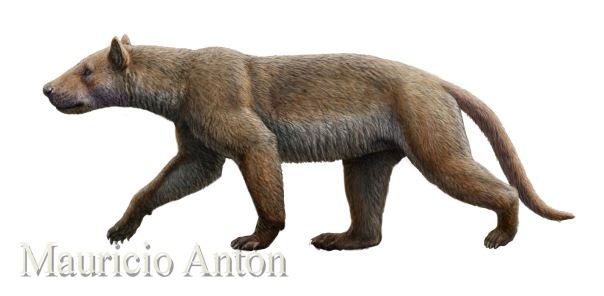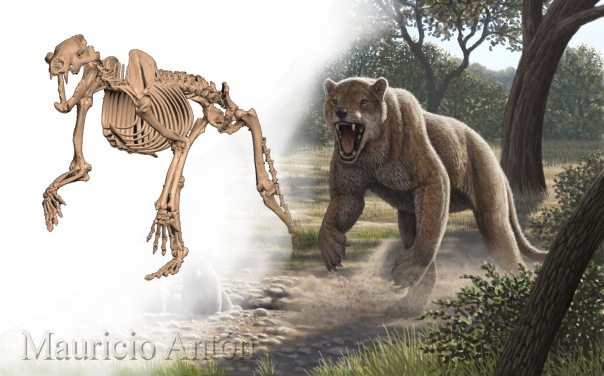Magericyon: from fossil to virtual to art
One of the illustrations I did for the exhibition about Batallones fossil sites represents an adult female of the amphicyonid Magericyon agressively protecting its cubs. Such behaviour scenes, which imply portraying the animals in action, are quite complex to produce. Much of my “paleoartistic” work implies to establish the appearance of extinct animals that have never been depicted before, and the end result of such reconstructions is usually a picture of the animal in broadside view, standing or walking leisurely, so that the body proportions are seen most clearly.
This reconstruction of Magericyon is an example of such “canonic” ilustrations

But when it comes to depict action, we need to see the animal as a 3-dimensional dynamic structure of bone, muscle and fur with the infinite possible combinations of posture, light and point of view. Virtual 3D technology can prove enormously helpful in all the stpes of this process.
In the previous months I had been collaborating with paleontologist Gema Siliceo in the creation of a virtual skeleton of Magericyon to be used in her Phd thesis dissertation about this carnivore, a task that involved many hours of work. First, each bone had to be scanned and the scans turned into virtual 3D objects, which then needed to be assembled in an anatomically correct virtual skeletal mount. This implied to create mirror copies of limb bones that were represented on one side only, and in a few cases to model missing bones by hand. Most importantly, the bones had to be articulated to each other in the correct angles, and for this task Gema’s painstaking study of the functional anatomy of Magericyon was vital. For example, she determined that the hind feet of this animal would have been essentially plantigrade, an important bit of information when we deal with a diverse family of extinct carnivores that included both plantigrade and digitigrade species.
Here we see a render of the virtual 3d skeleton of Magericyon, which served as a basis for the flesh reconstruction above

Returning to the action scene, I had created some preliminary pencil sketches showing the angry mother charging some invisible enemy. In those drawings I tried to approximate from memory how this amphicyonid would look if seen in mid-leap and in perspective

Then, I articulated the virtual skeleton in the desired pose and rendered it with different focal lenghts until I found an image that fit closely with the concept shown in my early sketches

Using the 3D render as a reference I could develop more detailed sketches and make sure that the drawings were faithful to the shape and proportions of the animal’s skeleton

From there on, the process was one of good-old digital painting, creating the right textures, illumination and mood

Nothing can take the place of pencil and paper, but there is no denying the contribution of digital technology to paleoart. With the time and resources it is possible and desirable to combine the best of both worlds

And there is more: we used this digital 3D model as a basis for a virtual animated reconstruction of the skeleton and the living animal, an exclusive feature that can be seen at the Batallones exhibit in Alcalá de Henares, Madrid. Well worth visiting!
Posted on 30/05/2018, in Uncategorized. Bookmark the permalink. 3 Comments.
Los Battallones is a fossil site of international renown. What a pity that the scientific catalogue of the exhibition wasn’t published in English!
Deffinitivelly not a mother you shuld mess up with. Great pst as usual.
That musculature makes it look so catlike! Could it pronate its forelimbs more than your average canid?